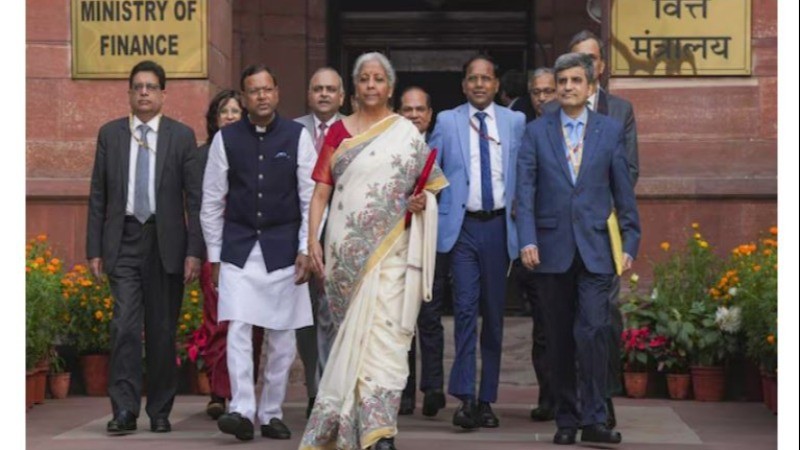
Union Budget 2025: Key Highlights from Nirmala Sitharaman’s Speech: Finance Minister Nirmala Sitharaman presented the Union Budget 2025 in Parliament on Saturday, marking her eighth consecutive budget making it an unprecedented achievement. This budget comes against the backdrop of economic slowdown and demands for middle-class tax relief.
India’s Economic Outlook Amid Global Uncertainties
The global economy faces challenges such as high asset prices, political instability, and disruptions in shipping. Despite these uncertainties, India stands out as a "shining exception" with stable inflation, a 4% target, and robust economic growth.
The interim budget prioritized four key groups include: Garib (Poor), Mahilayen (Women), Yuva (Youth) and Annadata (Farmers)
Key measures included a rise in Minimum Support Prices (MSPs) for crops and the continuation of the Pradhan Mantri Garib Kalyan Anna Yojana.
Full-Year Budget: Key Themes
The 2025 budget focussed on employment, MSME growth, skill development especially focussed on middle-class support. A package of five major schemes, with an outlay of Rs.2.00-lakh-Cr over 5 years, aims to generate employment and skill development opportunities for 4.1 crore youth. An allocation of Rs.1.48 lakh crore is dedicated to education, employment, and skilling programs.
Nine Budget Priorities for "Viksit Bharat"
The budget outlines nine key priorities:
Key Sectoral Announcements
1. Agriculture
Launch of 109 high-yield and climate-resilient crop varieties.
Promotion of natural-farming among 1.00 crore farmers.
Digital Public Infrastructure (DPI) integration in agriculture.
Shrimp production and export boost.
Rs.1.52-lakh-Cr allocated for agriculture and allied sectors.
2. Employment & Skilling
Three new Employment Linked Incentive (ELI) schemes for job creation.
Women workforce participation initiatives.
A centrally sponsored skilling scheme for 20.00-Lakh youth.
Revised Model Skill Loan Scheme with loans up to Rs.7.5 lakh.
Education loans up to Rs.10 lakh with financial support.
3. Human Resource Development & Social Justice
Universal coverage of social programs.
"Purvodaya" plan to develop eastern states.
Capital funding for Andhra Pradesh, including the Polavaram project.
Over 3.00 crore new houses under Prime Minister Awas Yojana.
Rs.3.00-Lakh-Cr allocated for schemes benefiting women and girls.
Banking expansion in North-Eastern regions.
Rs.2.66 lakh crore allocated for rural development.
4. Manufacturing & Services
Micro, Small and Medium Enterprises (MSME) support through a new Credit Guarantee Scheme.
Mudra loan limit raised to Rs.20 lakh.
E-commerce Export Hubs development.
Internship opportunities in top companies for 1.00 crore youth.
Rental housing for industrial workers.
Critical Mineral Mission and offshore mineral mining.
Simplification of business closure processes.
5. Urban Development
"Cities as Growth Hubs" initiative.
Transit-oriented development plans for major cities.
PM Awas Yojana Urban 2.0 to benefit 1 crore urban families.
Investment in sewage treatment and solid waste management.
Incentives for states to moderate stamp duty rates.
6. Energy Security
Policy on energy transition strategies.
P M Surya GharMuftBijli Yojana for rooftop solar power.
Support for small modular nuclear reactors development.
Encouragement of clean energy adoption for small industries.
7. Infrastructure
Rs.11.11 lakh crore allocated for capital expenditure (3.4% of GDP).
Incentives for private and state investment in infrastructure.
Launch of PMGSY Phase IV for rural connectivity.
Development of tourism infrastructure.
8. Innovation, Research & Development
Anusandhan National Research Fund operationalization.
Private sector-driven research and innovation models.
Venture capital funding for the space economy.
9. Next-Generation Reforms
Creation of a National Economic Policy Framework.
Incentives for states to accelerate economic reforms.
Land and labor reforms to boost productivity and market facilitation.
The Union Budget-2025 sets an ambitious roadmap for India's economic transformation, focusing on employment, growth, and inclusive development. With a clear vision for "Viksit Bharat," the government aims to build a stronger, more resilient economy while ensuring welfare for all.
Mixed Trends in Stock Markets: Sensex, Nifty Special Session Ended in Mixed Note
Benchmark indices BSE Sensex and the NSE Nifty-50 ended flat amid high volatility in today's special trading session held in connection with the Union Budget. After a four-day winning streak, the markets took a breather, swinging between gains and losses.
BSE Sensex closed 5.39 points, or 0.01 percent, higher at 77,505.96, while the NSE Nifty 50 settled 26.25 points, or 0.11 percent, lower at 23,482.15,
However, strong performance in consumption-driven sectors helped cushion the fall. The FMCG sector rose by 3.1 percent, while the auto sector gained 2.1 percent, supported by cuts in personal income tax rates designed to boost spending in Asia's third-largest economy.